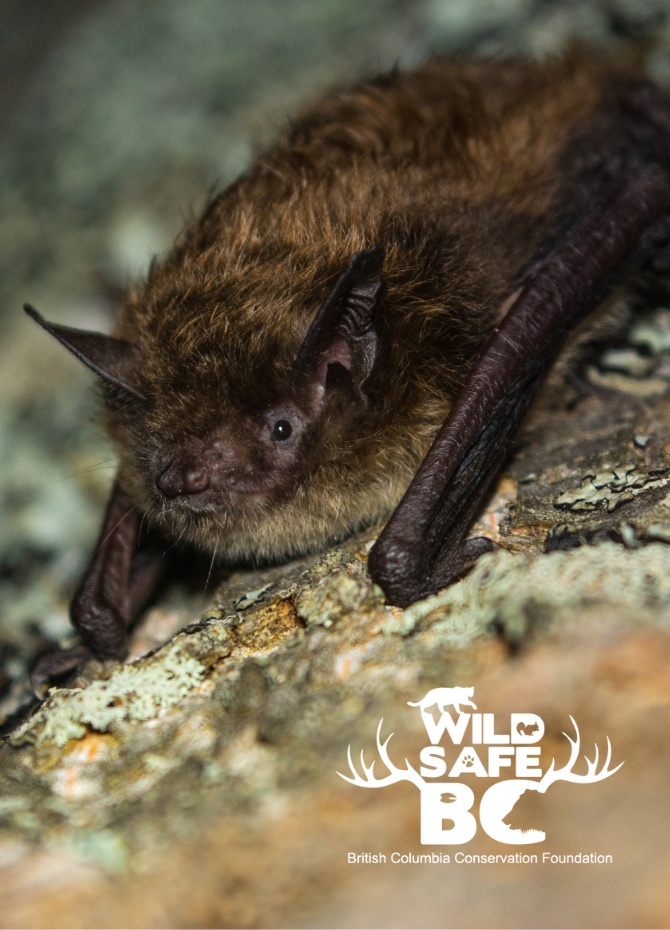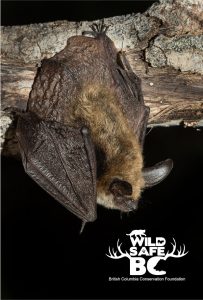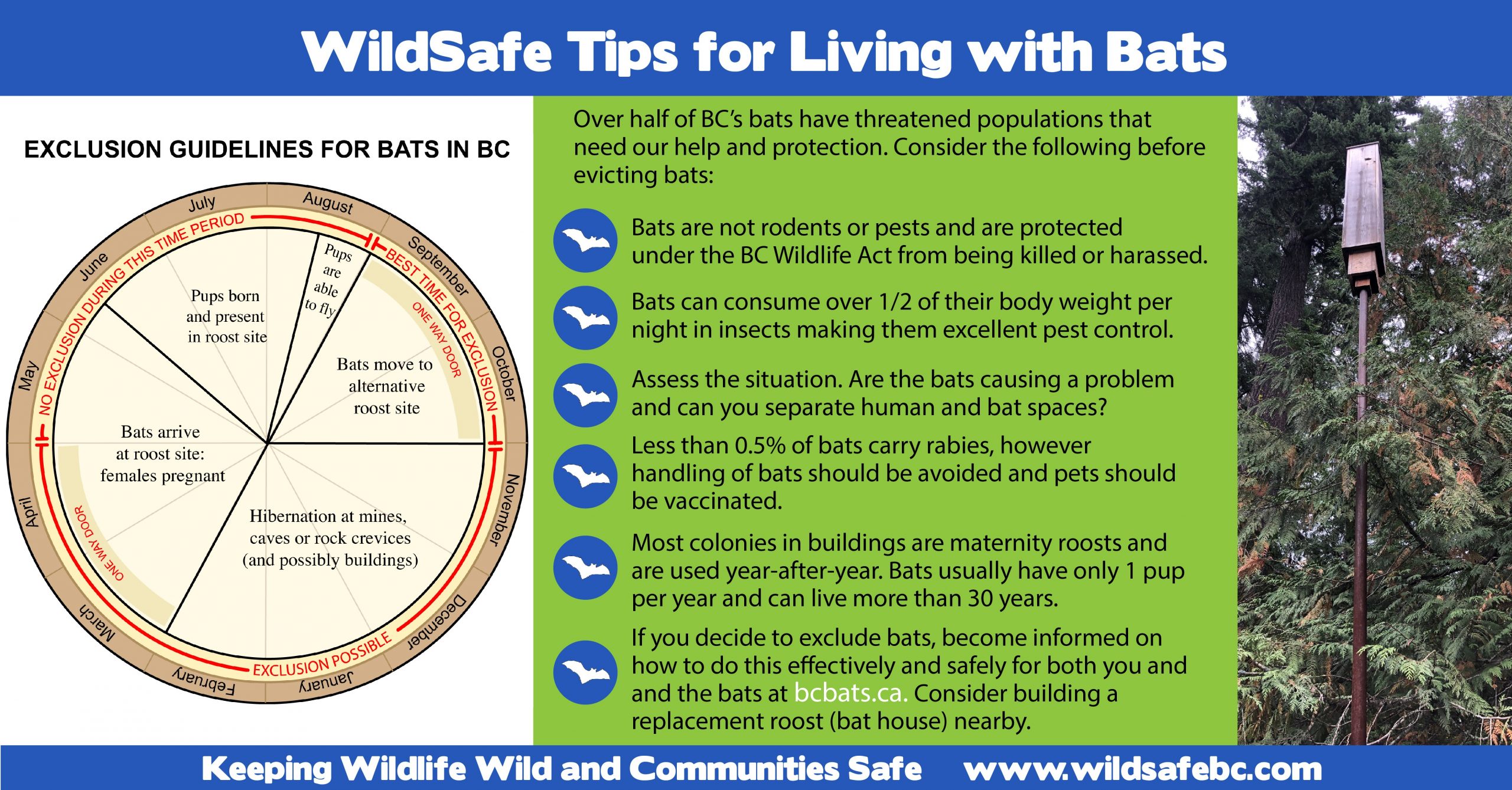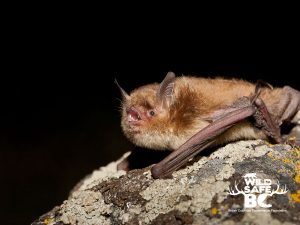Bats
 Bat Snapshot
Bat Snapshot
Bats are the only flying mammal in BC (the flying squirrel is really a glider). All BC bats are insectivores and can eat more than half of their body weight in insects each night. This makes them important allies for managing insect pests that impact agriculture as well as forests.
There are 15 species of bats known to breed in BC. This number can vary slightly as increased surveys and new information becomes available. Bats in BC face many threats including habitat loss, direct persecution from humans, predation by domestic cats, and White-Nose Syndrome. About half of BC’s bats are listed as “species-at-risk” with populations considered vulnerable or threatened with extinction.
Bats are currently the only animals known to carry rabies in BC however less than 0.5% of wild bats test positive. Nevertheless, it is important to use precautions to avoid being bitten or scratched by a bat and to ensure pets receive the rabies vaccine. If you are bitten or scratched, seek immediate medical attention.
Conflicts with bats are rare unless they accidentally fly into your home or roost in an inappropriate area such as a shared living space. Bats have been known to enter dime-sized holes to establish summer roosts in attics. Explore our Conflict Reduction page on tips to manage these situations. Bats are neither rodents or pests and are protected under the BC Wildlife Act and other legislation from harm, harassment and intentional killing.
Bats are fascinating mammals and you can help them by learning more about them, planting appropriate plants, installing bat houses, engaging in citizen science, and becoming a “Bat-friendly Community”. Learn more by visiting bcbats.ca.
Wild Bat Facts
- There are approximately 15 species of bats known to breed in BC
- Bats are not rodents or pests and are legally protected from harm, harassment and intentional killing
- All BC bats are insectivores and will eat more than half their body weight in insects each night
- Although bats mate in the fall, females do not initiate pregnancy until spring, and only if they have enough fat reserves
- Bats will hibernate up to six months of the year in dens called hibernacula. Little is known about their locations in BC
- In summer, female bats will roost together in maternal colonies to raise their young called pups
- Bats are slow-reproducers and will typically only produce one pup per year
- The oldest-known wild Little Brown Myotis was 31 years old when last captured
- All BC bats are relatively small and tend to be less than a house sparrow in size
- Bats are not blind but primarily rely on echolocation to locate their prey
- Bats can go into a mini-hibernation, day or night, called torpor to reduce their energy expenditure
- Bats can have an extreme range of heartbeats per minute from over 1000 when flying to less than 25 when hibernating (depending on species)
- White-Nose Syndrome is a devastating diseases that has killed over 6 million bats in North America and wiped out entire colonies
Identification
Bats are the only mammals capable of sustained, flapping flight. They are readily identified by their flight membrane with little to no fur while the rest of their body is well-furred. They tend to have large ears and small eyes. All of BC bats are small, weighing between 3.5 and 26 g – all smaller than a house sparrow. Identifying different species of bats on the wing is nearly impossible, however using “bat detectors” and echolocation recording software can help narrow down species.
Biology
Bats are long-lived, slow-reproducing mammals that typically only produce one or two pups per year. The oldest recorded bat in BC was captured and released at the age of 30. Bats mate in the fall but do not become pregnant until after they leave their den (hibernacula) in the spring. After 7 to 10 weeks the pup(s) are born and raised in maternal colonies. Pups will begin to fly and forage for food after one month. The first winter can be hard for juvenile bats and many perish.
Bats expend significant energy when flying and will often go into a reduced metabolic state called torpor to conserve energy. This can occur day or night depending on conditions. In winter, bats will either migrate to warmer climes or seek out abandoned mines, rock crevices, or caves. They are seeking areas with stable temperatures above freezing and enough moisture to avoid drying out. Bats are true hibernators and their heart rate can lower to less than 25 beats per minute and their body temperature will drop to almost the same as their surroundings.
White-nosed Syndrome (WNS) is a fungus that was introduced to Eastern North America from Europe and is making its way westward. It was reported in Washington State in 2016, and monitoring is ongoing in BC. The fungus that causes WNS was detected in the Grand Forks area in 2022, but there have not been any bats with WNS found in BC to date (April, 2024). The fungus itself does not kill the bat but infects the skin of hibernating bats. This irritates them and rouses them from their slumber. This uses up valuable energy in a time when there are no insects to replenish their stores. Millions of bats have died from starvation as a result.
Bats are not blind but do rely on echolocation for locating their prey. All BC Bats are insectivores and some species will specialize on different types of insects. Bats are predated upon by other animals such as owls, hawks, raccoons and domestic house cats.
Behaviour
Bats are crepuscular which means they are most active at dawn and dusk, but some will also be active overnight (nocturnal). They are often found foraging near bodies of water, where insect concentrations are highest.
Bats use echolocation by emitting short bursts of ultrasonic sounds (above the range of human hearing) from their larynx. As the sounds bounce back, this gives the bats information on the object’s size, shape and distance. They also use these sounds for communication along with audible chirps and clicks.
Range and Habitat
Bats are found in many parts of the province however research is ongoing. Some bats migrate while others do not. While some large bat colonies are known in North America, BC bats tend to hibernate in smaller colonies that are hard to find. If you know of a bat maternal roost, you can help contribute to bat science by becoming involved in bat monitoring and counts.
Bat Safety
Bats are timid animals that are not often seen during the day and tend to avoid humans when they are feeding. Occasionally, bats will fly into a home by accident or establish a maternal summer roost in an attic. While only less than 0.5% of wild bats have rabies, it is a serious illness that can be fatal. The virus is transmitted through a bat scratch or bite.
Not all bats that have rabies exhibit symptoms, however, some that do will appear sick and weak. Be wary of bats that are acting strangely or flying during the day. Never pick up a sick or dead bat with bare hands. Use gloves or a shovel to gently move a sick bat away from human activity. Use a plastic bag to remove a dead bat. Ensure your dogs and cats are vaccinated for rabies. If your pet has had contact, or suspected contact with a bat, contact your vet immediately. Untreated, your pet could pass the virus on to you or others. If you suspect you have been bitten or scratched by a bat, seek immediate medical attention. The newer human vaccine is much more tolerable compared to the stomach shots of the past. For more information, refer to the BC CDC.
While the risk of acquiring a disease through bat guano in BC is low, it is recommended to moisten guano with water before sweeping it up and to wear a mask.
Conflict Reduction with Bats
If a bat flies in your home there is no cause for alarm. Simply open all exterior doors and windows, turn off ceiling fans and lights and wait for the bat to find its way out. If the bat seems unable to find its way out and settles on a surface, you can use a box and a piece of cardboard to safely capture the bat. When you bring it outside, do not place the bat on the ground but place the box next to an elevated location such as a tree limb. For more tips, visit the Bat Conservation International website.
If you have bats residing in your attic, first consider if they need to be moved. If human living areas are sealed away from the maternal roosts, coexisting is possible. Many home-owners happily coexist with bat colonies. Find out more about best management practises for living with bats in buildings at www.bcbats.ca.
If you prefer to exclude the bats from your attic, you must consider timing to avoid trapping the bats inside by referring to the bat exclusion calendar. Bats should not be evicted late spring and summer when female bats are roosting and raising young. You may also want to install a bat house nearby to assist in the eviction of your bats. Refer to Bat Conservation International for bat exclusion techniques, or contact a qualified professional. Remember, bats are protected under the BC Wildlife Act and may not be harassed, harmed, or killed.
To prevent bats from entering a building, inspect the exterior and seal all openings.

 Bat Snapshot
Bat Snapshot
Bats are the only flying mammal in BC (the flying squirrel is really a glider). All BC bats are insectivores and can eat more than half of their body weight in insects each night. This makes them important allies for managing insect pests that impact agriculture as well as forests.
There are 15 species of bats known to breed in BC. This number can vary slightly as increased surveys and new information becomes available. Bats in BC face many threats including habitat loss, direct persecution from humans, predation by domestic cats, and White-Nose Syndrome. About half of BC’s bats are listed as “species-at-risk” with populations considered vulnerable or threatened with extinction.
Bats are currently the only animals known to carry rabies in BC however less than 0.5% of wild bats test positive. Nevertheless, it is important to use precautions to avoid being bitten or scratched by a bat and to ensure pets receive the rabies vaccine. If you are bitten or scratched, seek immediate medical attention.
Conflicts with bats are rare unless they accidentally fly into your home or roost in an inappropriate area such as a shared living space. Bats have been known to enter dime-sized holes to establish summer roosts in attics. Explore our Conflict Reduction page on tips to manage these situations. Bats are neither rodents or pests and are protected under the BC Wildlife Act and other legislation from harm, harassment and intentional killing.
Bats are fascinating mammals and you can help them by learning more about them, planting appropriate plants, installing bat houses, engaging in citizen science, and becoming a “Bat-friendly Community”. Learn more by visiting bcbats.ca.
Wild Bat Facts
- There are approximately 15 species of bats known to breed in BC
- Bats are not rodents or pests and are legally protected from harm, harassment and intentional killing
- All BC bats are insectivores and will eat more than half their body weight in insects each night
- Although bats mate in the fall, females do not initiate pregnancy until spring, and only if they have enough fat reserves
- Bats will hibernate up to six months of the year in dens called hibernacula. Little is known about their locations in BC
- In summer, female bats will roost together in maternal colonies to raise their young called pups
- Bats are slow-reproducers and will typically only produce one pup per year
- The oldest-known wild Little Brown Myotis was 31 years old when last captured
- All BC bats are relatively small and tend to be less than a house sparrow in size
- Bats are not blind but primarily rely on echolocation to locate their prey
- Bats can go into a mini-hibernation, day or night, called torpor to reduce their energy expenditure
- Bats can have an extreme range of heartbeats per minute from over 1000 when flying to less than 25 when hibernating (depending on species)
- White-Nose Syndrome is a devastating diseases that has killed over 6 million bats in North America and wiped out entire colonies
Identification
Bats are the only mammals capable of sustained, flapping flight. They are readily identified by their flight membrane with little to no fur while the rest of their body is well-furred. They tend to have large ears and small eyes. All of BC bats are small, weighing between 3.5 and 26 g – all smaller than a house sparrow. Identifying different species of bats on the wing is nearly impossible, however using “bat detectors” and echolocation recording software can help narrow down species.
Biology
Bats are long-lived, slow-reproducing mammals that typically only produce one or two pups per year. The oldest recorded bat in BC was captured and released at the age of 30. Bats mate in the fall but do not become pregnant until after they leave their den (hibernacula) in the spring. After 7 to 10 weeks the pup(s) are born and raised in maternal colonies. Pups will begin to fly and forage for food after one month. The first winter can be hard for juvenile bats and many perish.
Bats expend significant energy when flying and will often go into a reduced metabolic state called torpor to conserve energy. This can occur day or night depending on conditions. In winter, bats will either migrate to warmer climes or seek out abandoned mines, rock crevices, or caves. They are seeking areas with stable temperatures above freezing and enough moisture to avoid drying out. Bats are true hibernators and their heart rate can lower to less than 25 beats per minute and their body temperature will drop to almost the same as their surroundings.
White-nosed Syndrome (WNS) is a fungus that was introduced to Eastern North America from Europe and is making its way westward. It was reported in Washington State in 2016, and monitoring is ongoing in BC. The fungus that causes WNS was detected in the Grand Forks area in 2022, but there have not been any bats with WNS found in BC to date (April, 2024). The fungus itself does not kill the bat but infects the skin of hibernating bats. This irritates them and rouses them from their slumber. This uses up valuable energy in a time when there are no insects to replenish their stores. Millions of bats have died from starvation as a result.
Bats are not blind but do rely on echolocation for locating their prey. All BC Bats are insectivores and some species will specialize on different types of insects. Bats are predated upon by other animals such as owls, hawks, raccoons and domestic house cats.
Behaviour
Bats are crepuscular which means they are most active at dawn and dusk, but some will also be active overnight (nocturnal). They are often found foraging near bodies of water, where insect concentrations are highest.
Bats use echolocation by emitting short bursts of ultrasonic sounds (above the range of human hearing) from their larynx. As the sounds bounce back, this gives the bats information on the object’s size, shape and distance. They also use these sounds for communication along with audible chirps and clicks.
Range and Habitat
Bats are found in many parts of the province however research is ongoing. Some bats migrate while others do not. While some large bat colonies are known in North America, BC bats tend to hibernate in smaller colonies that are hard to find. If you know of a bat maternal roost, you can help contribute to bat science by becoming involved in bat monitoring and counts.
Bat Safety
Bats are timid animals that are not often seen during the day and tend to avoid humans when they are feeding. Occasionally, bats will fly into a home by accident or establish a maternal summer roost in an attic. While only less than 0.5% of wild bats have rabies, it is a serious illness that can be fatal. The virus is transmitted through a bat scratch or bite.
Not all bats that have rabies exhibit symptoms, however, some that do will appear sick and weak. Be wary of bats that are acting strangely or flying during the day. Never pick up a sick or dead bat with bare hands. Use gloves or a shovel to gently move a sick bat away from human activity. Use a plastic bag to remove a dead bat. Ensure your dogs and cats are vaccinated for rabies. If your pet has had contact, or suspected contact with a bat, contact your vet immediately. Untreated, your pet could pass the virus on to you or others. If you suspect you have been bitten or scratched by a bat, seek immediate medical attention. The newer human vaccine is much more tolerable compared to the stomach shots of the past. For more information, refer to the BC CDC.
While the risk of acquiring a disease through bat guano in BC is low, it is recommended to moisten guano with water before sweeping it up and to wear a mask.
Conflict Reduction with Bats
If a bat flies in your home there is no cause for alarm. Simply open all exterior doors and windows, turn off ceiling fans and lights and wait for the bat to find its way out. If the bat seems unable to find its way out and settles on a surface, you can use a box and a piece of cardboard to safely capture the bat. When you bring it outside, do not place the bat on the ground but place the box next to an elevated location such as a tree limb. For more tips, visit the Bat Conservation International website.
If you have bats residing in your attic, first consider if they need to be moved. If human living areas are sealed away from the maternal roosts, coexisting is possible. Many home-owners happily coexist with bat colonies. Find out more about best management practises for living with bats in buildings at www.bcbats.ca.
If you prefer to exclude the bats from your attic, you must consider timing to avoid trapping the bats inside by referring to the bat exclusion calendar. Bats should not be evicted late spring and summer when female bats are roosting and raising young. You may also want to install a bat house nearby to assist in the eviction of your bats. Refer to Bat Conservation International for bat exclusion techniques, or contact a qualified professional. Remember, bats are protected under the BC Wildlife Act and may not be harassed, harmed, or killed.
To prevent bats from entering a building, inspect the exterior and seal all openings.




